| Risk / Reward Ratios ... a continuation of Part I |
I was recently reading Bernstein's Frontier article and got to thinking.
>Now that was a mistake.
Pay attention.
It is customary to say that an investor who takes on more Risk
expects higher Returns.
It is also customary to define Risk
as Standard Deviation or Volatility.
>And what's the Reward, as in Risk / Reward Ratio?
Often, it's taken as simply the Return on our Portfolio, so we would say:
(1) Risk/Reward = (Standard Deviation)/(Portfolio Return)
Or, the Reward might be the Return on our Portfolio, over and above some risk-free rate, so we would say:
(2) Risk/Reward = (Standard Deviation)/(Portfolio Return - RiskFree)
The reciprocal of the Ratio in (2) is called the Sharpe Ratio.
In Part I we saw that the Standard Deviation increases (sort of) as the square-root of the time period.
However, our Return, over longer and longer periods of time, increases
more dramatically.
For example, suppose:
- Our annualized Portfolio Return was 8%
so our Portfolio would grow according to (1.08)N , over N years - The annualized Standard Deviation (or Volatility) of our Portfolio was SD = 20%
so this would grow as the years progressed as 0.2 SQRT(N) (according to that square-root-of-time stuff) - The Ratio would be: SD / Return = 0.2 SQRT(N) / (1.08)N
which would look like this:
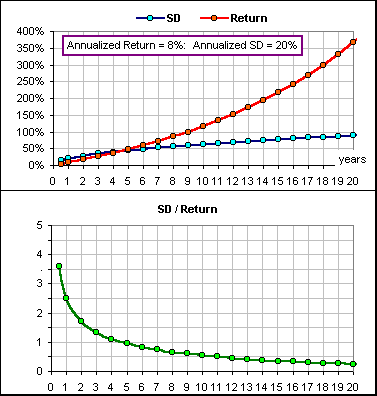
Figure 1
|
>I assume it's not that smooth in real life, eh? True. >If you used the actual return, over umpteen years, what'd it look like? If I used the actual cumulative return and used that square-root increase in Standard Deviation I'd get this: 
>But I thought that square-root stuff was okay for short periods of time and you're talking here about mega-years. Yes, you're right. So let's do it again with ... >Hold on! I thought you didn't like using Risk = Standard Deviation. | 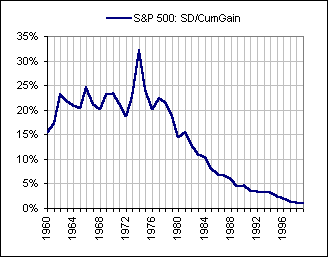
|
- We'll define Risk as the Probability that our annualized Portfolio Return, R, is less than, say 3%.
- We'll define Reward as the Probability that R is greater than, say 8%.
- We'll then consider the Ratio: Risk / Reward = Probability(R<3%) / Probability(R>8%)
>What's so special about 3% and 8%?
Nothing. It's just an example. We might consider 3% as some risk-free return or maybe inflation,
so our Risk is the probability of getting a Return less than inflation.
If we get a return greater than 8% we'd be ecstatic. That's a real return of 5% above a
3% inflation rate. That's our Reward, but it's a
personal thing. You plug in whatever numbers you like.
>So?
So let's investigate:
|
First we'll assume that our Returns are Normally distributed with Mean M
and Standard Deviation S. The cumulative distribution looks like so 
in the case M = 8% and S = 20%. The cumulative distribution gives the probability that a return is less than any given number. In this case we're looking at the probability that a return is less than 3% (that's the red arrow: 0.39) and less than 8% (the green arrow: 0.50). The probability that a Return R is greater than 8%, namely Probability(R>8%), is then 1 - Probability(R<8%).
|
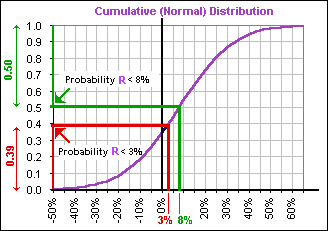 Figure 2 |
For the case illustrated in Figure 2, it's 0.39/0.50 = 0.78 (which is ratio of the two double-arrow lengths illustrated in the Figure: the red divided by the green).
In general, for a Normal distribution of Returns, we get the Magic Formula:
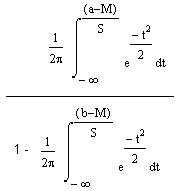
|
>What! You gotta be kidding! I think ...
Wait! I just wanted to illustrate that, mathematically speaking, this particular Risk/Reward
Ratio depends upon two numbers,
(a - M)/S and (b - M)/S, where "a" and "b" are returns.
Do you recognize this format?
>Are you kidding?
They're Sharpe Ratios, as we saw in equation (2), above.
>Yeah, but why don't you just show a picture or two?
Okay, here's a picture:
We start in 1950 and
- Determine the Mean of the 1-year Returns, then the Mean of the 5-year Returns, then 10-year, etc.
- Determine the Standard Deviation of 1-year, 5-year, 10-year etc. Returns.
- Assuming these Returns are Normally distributed, calculate the Risk/Reward Ratios for 1, 5, 10, etc. years using the Magic Formula above.
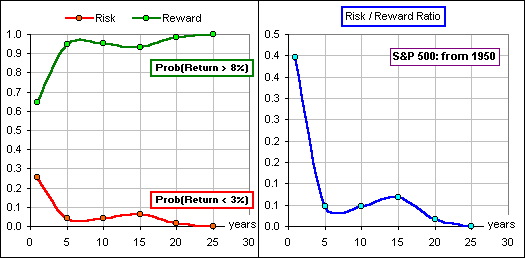
Figure 3
>What about starting in 1930 or 1970 or ...?
They all look about the same. As time marches on, the Risk goes down and the Reward goes up so that, after about twenty years, the Risk is negligible and the Reward is delectable.
>What about using 4% instead of 3% and 9% instead of ...?
They all look about the same. As time marches on, the Risk goes down and the Reward goes up ...
>Okay, but what if ... uh ... what if ...?
What if the returns are NOT distributed normally?
>Exactly my point!
And what about a negative Return being more heavily weighted than a 0% Return, when measuring Risk?
>Precisely!
Okay, here's what we'll do:
- We'll look at all the 1-year Returns, 2-year Returns, 3-year Returns etc. and see
which ones were less than 3%, then calculate the sum of the absolute value of the
deviations from 3%:
That is, for all Returns R < 3% we calculate Σ | R - 3 |
(This gives us our measure of Risk where the really BAD returns are weighted more heavily than those just under 3%.) - Similarly, we look at all the 1-year Returns, 2-year Returns, 3-year Returns etc. and see
which ones were greater than 8%, then calculate the sum of the absolute value of the
deviations from 8%:
That is, for all Returns R > 8% we calculate Σ | R - 8 |
(This gives us our measure of Reward.) - Then we calculate the Ratio of these two numbers, Risk / Reward, for 1-year, 2-year, 3-year etc. Returns.
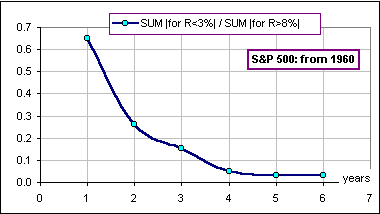
Figure 4
>Boring.
Yes. It doesn't take long for this Risk/Reward Ratio to become negligible.
>So what do you conclude about Risk / Reward Ratios?
It don't matter how you slice it, the longer you wait the smaller it gets and ...
>And it don't hardly matter which one you use!
Yes, but it's perhaps more interesting to compare Risk/Reward Ratios for different asset classes.
We've been doing the
S&P 500, but how do the Ratios compare for Large Cap Growth stocks or Bonds or ...
>So, do it!
Well, to start with, we can do Large and Small Cap Growth and Value Indices and our friend
the S&P 500 and the Total Stock Market ...
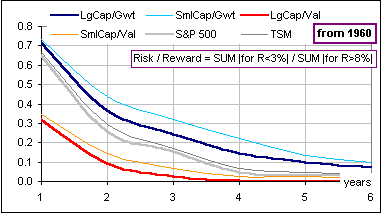
Figure 5
>Are we looking for the smallest Risk-Reward Ratio?
Why not?
>I'll take Large Cap Value!
How about adding some bonds or maybe ...
>Picture?
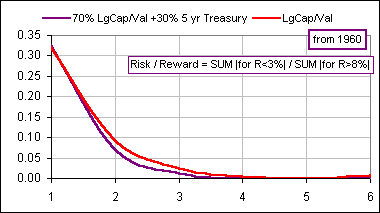
Figure 6
>So ... what are you suggesting?
Me? Suggesting? You're kidding. I just make pictures. Besides, a Portfolio which returns a fixed 7% would have Risk = 0 (because there are no returns less than 3%) and Reward = 0 (because there are no returns greater than 8%) so ...
>Don't tell me! Risk/Reward = 0/0. Is that good?
Not very. Besides, if two portfolios have constant returns of 9% and 12% they'd both have a Risk / Reward Ratio of 0 (since neither has returns less than 3%). So, on the basis of this definition of Risk/Reward, you wouldn't choose one over the other.
>So, what'll you do about it? Try another definition?
Gimme a minute to cogitate. In the meantime, y'all can check out this list of ratios.
 to continue
to continue